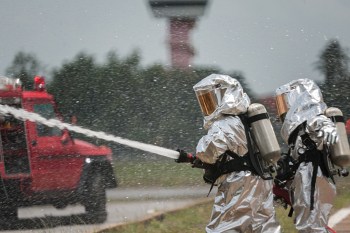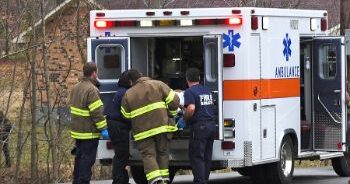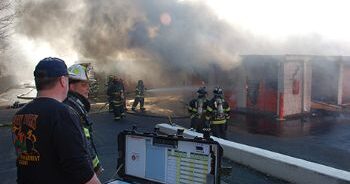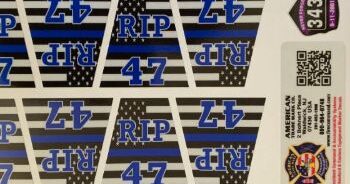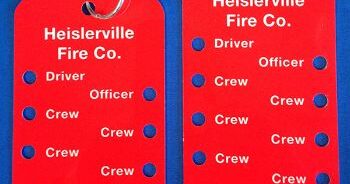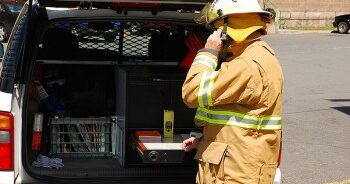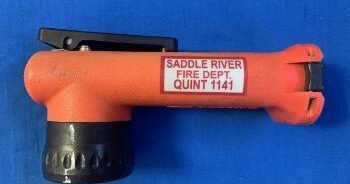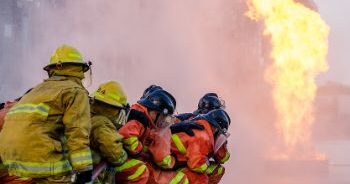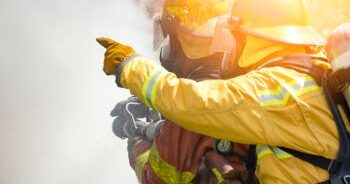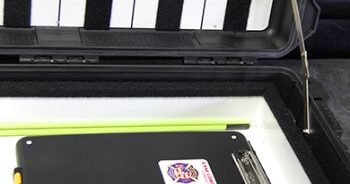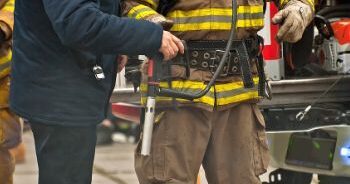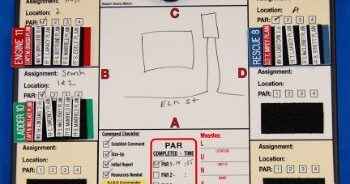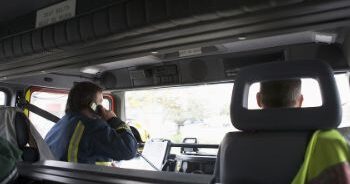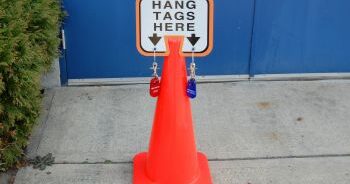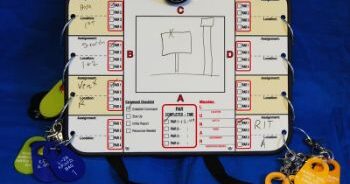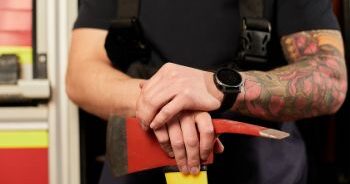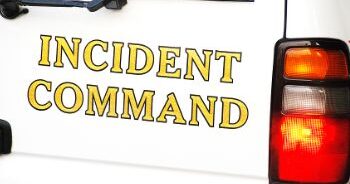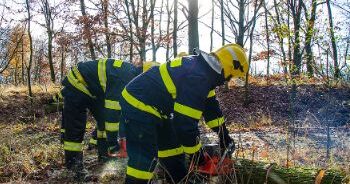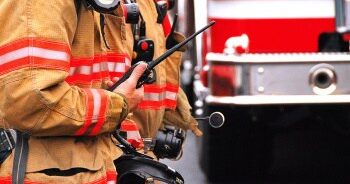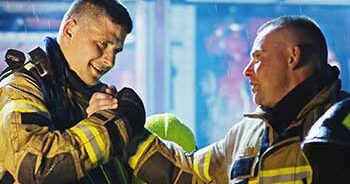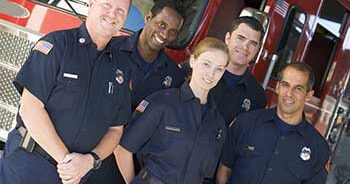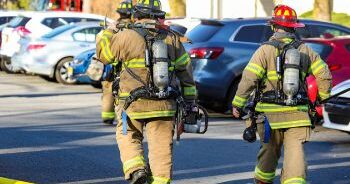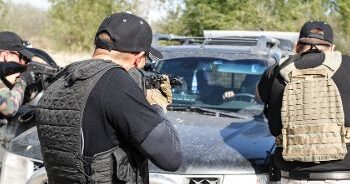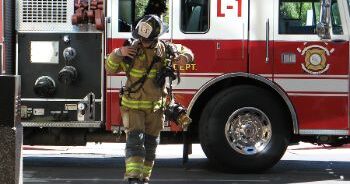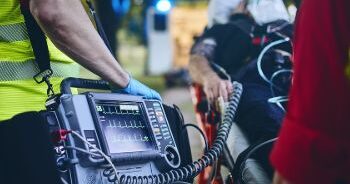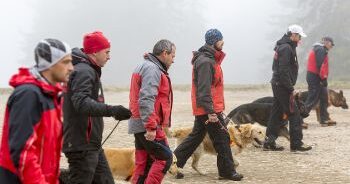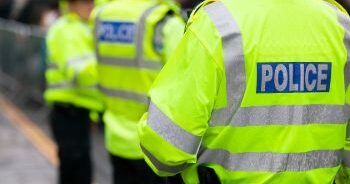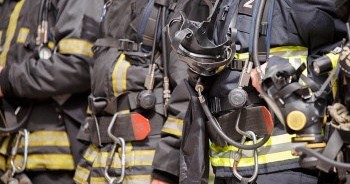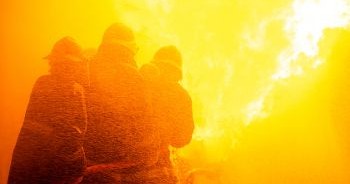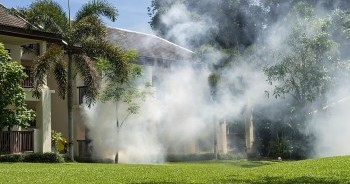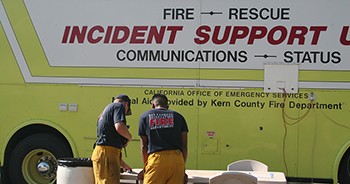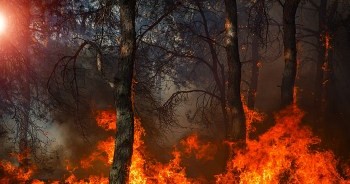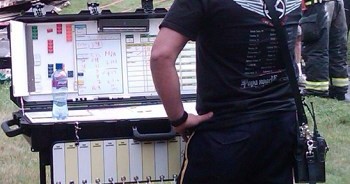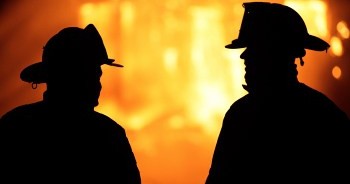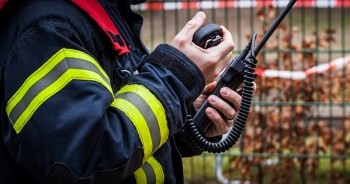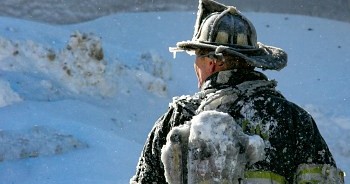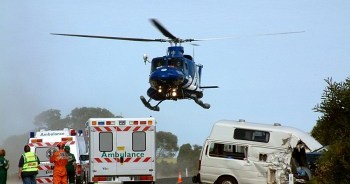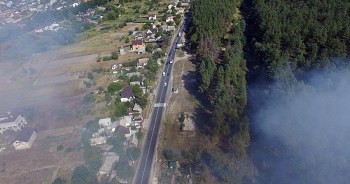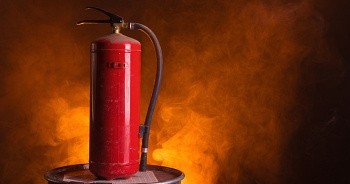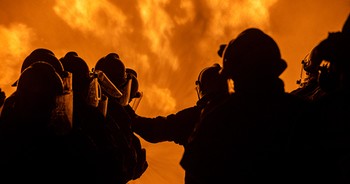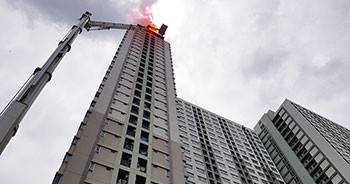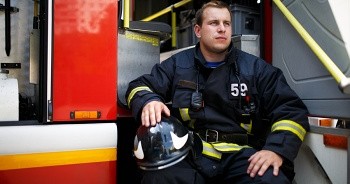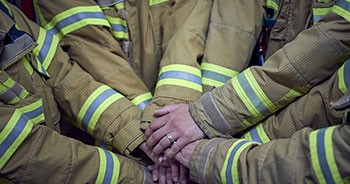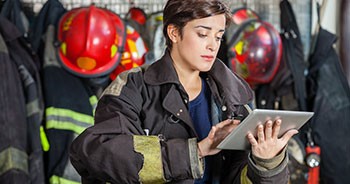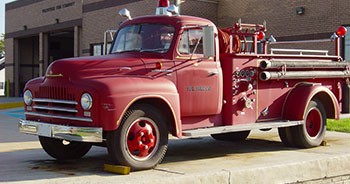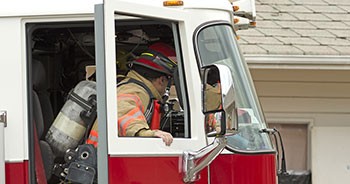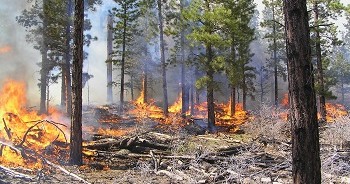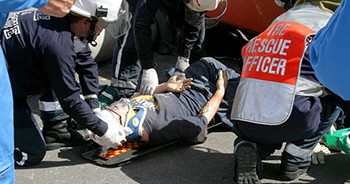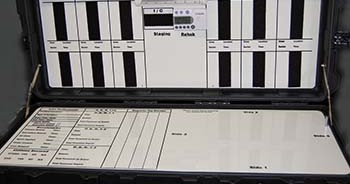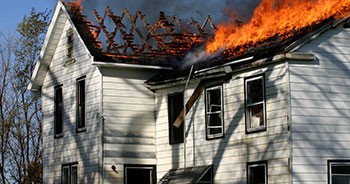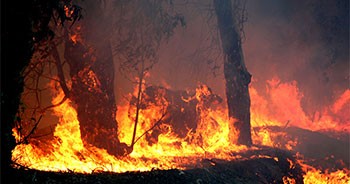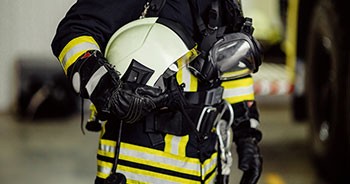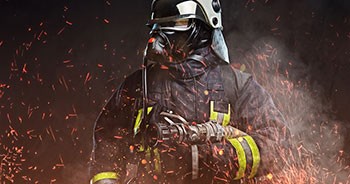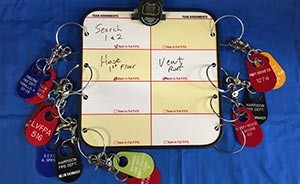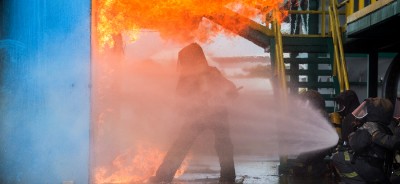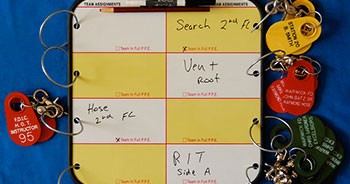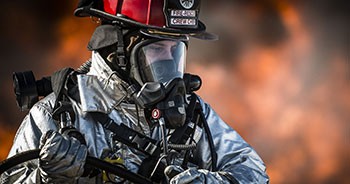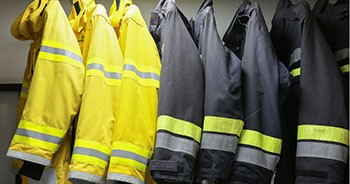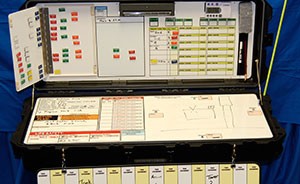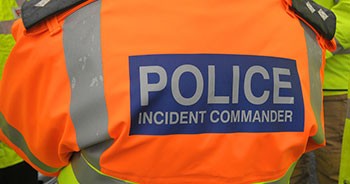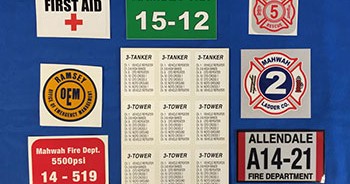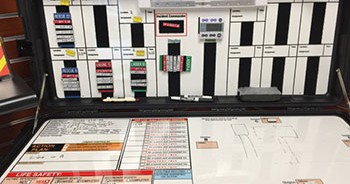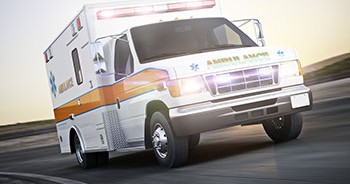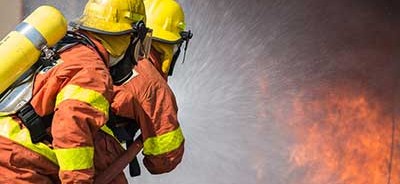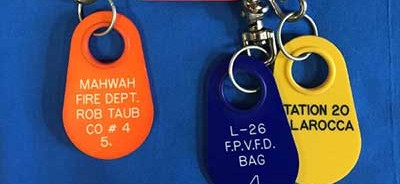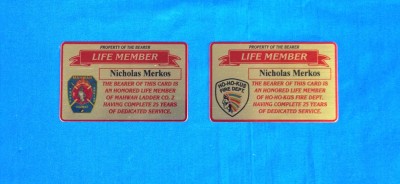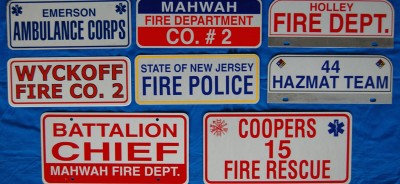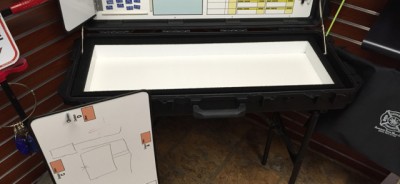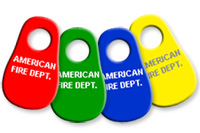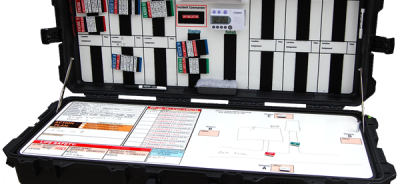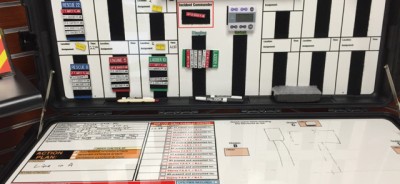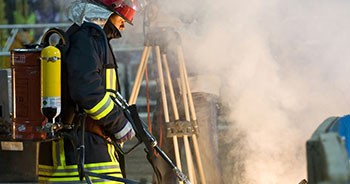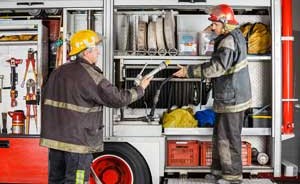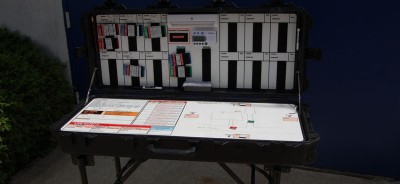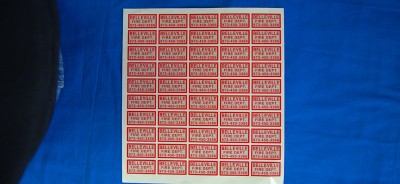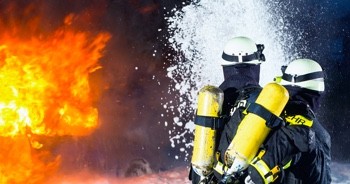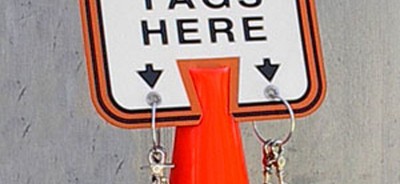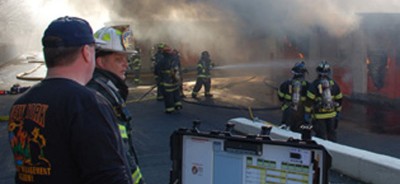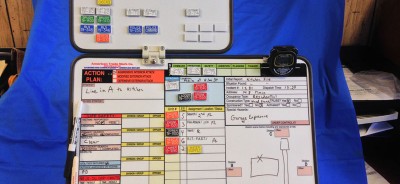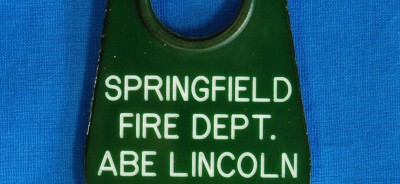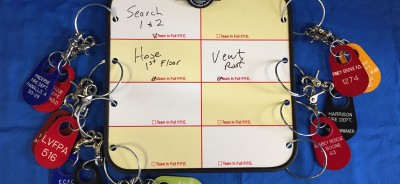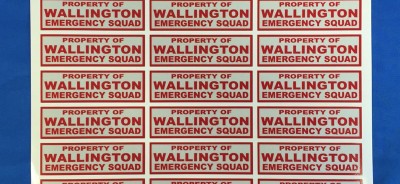Hazmat & Industrial Fires: Firefighter Safety Tips & Tools
Get, communicate with, and track the people and information you need during your next hazmat response call with tips and tools from American Trade Mark. Be better prepared for hazardous chemical and industrial fires. We want to help you maximize firefighter safety during all types of potential response situations.
Chemical Fire Response Challenges
Many hazmat firefighters find themselves in low-frequency, but very high-risk situations. Because of manufacturing, shipping, and waste cleanup efforts, even rural departments may have to respond to a hazardous materials release situation. So, training early and often is beneficial and essential.
Isolation, Decontamination & Disposal
As homes and businesses become more filled with modern building materials, furnishings, and textiles that grow toxic when burned, departments understand the growing need to protect firefighters from exposure. A hazmat response usually also involves isolation, decontamination, and disposal of these chemicals.
A Multi-Agency Effort
Getting the right professionals in and keeping others out of harm’s way is often a multi-agency effort. Police, EMS, local, state and even federal agencies may need to be notified and utilized. The specialized gear and number of responders required for these calls can also mean multiple smaller fire departments joining together. This means more people to track and communicate with.
8 Tips For Hazmat Fire Responders
You don’t want to wait until you’re on the way to an industrial fire, warehouse fire, or overturned chemical transportation vehicle to find out who knows how to approach hazmat threats effectively. We’ve put together eight tips to help your team feel more prepared, protected, and able to help others.
- Ensure everyone knows how to read hazardous material signs and labels, including U.S. Department of Transportation Placards (DOT Placards) and NFPA 704 Markings.
- Have an action plan in place – know your chain of communication, specifically for hazmat response. What agencies need to be called when?
- Provide training that includes information and hands-on experience.
- Avoid unnecessary exposure and contamination by sourcing and requiring proper hazmat equipment: hazmat suits, decon equipment, gas detectors, a NAERG (North American Emergency Response Guidebook), and Material Safety Data Sheets (MSDS).
- Arrive and stage a safe distance away from the scene.
- Watch out for tunnel vision – seeing the big picture (fire, explosion, etc.) and ignoring unseen dangers and vice versa.
- Isolate, evacuate, and deny entry – you want to protect the public and your fellow first responders from exposure to dangerous chemicals.
- Consider how the weather may affect the situation.
Prepare With Pre-Incident Surveys
OSHA also recommends doing pre-incident surveys of vulnerable local facilities, if possible. If you know a chemical manufacturing plant is in your jurisdiction, survey possible hazards and what features are in place to help you handle an emergency. What water supplies, suppression systems, confined spaces, and egress points are available to help you do your job at this specific location?
Helping Incident Command
Knowledge helps everyone stay alert and prevents downplaying a risky situation. Incident commanders have even more responsibility when it comes to a hazardous chemical situation. When dealing with substances that may be explosive, may react to air or water, and radioactive materials, time is of the essence. You have to collect information and make so many decisions, extremely quickly:
- Should this be an offensive or defensive attack?- What extinguishing agents are safe to use?
- Should you ventilate in this situation? What tools are safe (e.g. non-sparking tools)?
- Controlling the movement of who’s coming and going out of the fireground as known risks evolve.
- Getting trained personal and necessary safety equipment assigned to the right areas.
- Making sure medical officers have what they need to protect EMS teams and receiving hospitals.
- Providing accurate information to public relations so they can both warn and instill confidence in those who may be affected.
Helpful Communication & Accountability Tools
Choosing flexible firefighter accountability and incident command board systems that work for both your typical and hazmat call makes tracking both information and people simpler.
- The Steel Commander™ or Dashboard™ Commander Incident Command Systems may be the right mobile choice for you.
- Or, stay in place with our Case Commander® Incident Command System.
- Firefighter accountability tags also help you communicate the right information to the right people as new risks are uncovered and the scene changes.
- We have magnetic, dry erase command boards that are compatible with both traditional tags and passport tags.
Upgrade Your Hazmat Fireground Communications
Let American Trade Mark help your fire department respond to hazmat and industrial fires more safely and effectively. Order your incident command boards or firefighter accountability tags today. Or, call us to see how we can customize boards to benefit you. We look forward to enabling and supporting you on all types of response calls.
Related Posts
In the unpredictable environment of emergency response, ensuring EMS responders' safety in high-risk situations...
Firefighting is a demanding profession that requires precision, quick decision-making, and coordinated efforts to...
Helmet decals are more than a means of identification or decoration for firefighters. These...
The importance of firefighter accountability tags cannot be overstated in the realms of fire...
Firefighting is a challenging profession where every second matters and can be the difference...
Firefighter equipment markers have a crucial role in ensuring fire services' safety and efficiency....
Ensuring firefighter safety amidst the challenges posed by electrical fires is a paramount concern...
Ensuring firefighter safety in high-risk industrial settings requires strict adherence to safety protocols and...
In the dynamic and demanding world of emergency response, every second counts. It's essential...
As the popularity of food trucks continues to grow, first responders need to have...
Incident command places immense pressure on your leadership team. Rapid decision-making during an emergency...
When emergencies strike, effective incident command strategies save lives. However, methods employed to manage...
Are you looking to improve your communications when deploying your incident command truck in...
Crew-based accountability is essential for firefighters to do their job successfully, and accountability tags...
While training to send and receive mayday calls is part of every firefighter trainee's...
At American Trade Mark, we know just how grueling but rewarding a career in...
According to statistics from the National Institute for Occupational Safety & Health, many of...
During one firefighting incident, just five firefighters responded to a call for help about...
Firefighters often arrive first on the scene of not only fires but national disasters...
Every day, firefighters risk their lives to save people and property, which makes implementing...
A building collapse situation has the potential for serious harm to emergency personnel with...
First Responders should have five functional areas set up within their Incident Command Systems...
American Trade Mark wants to ensure that every hero gets home safely, which is...
At American Trade Mark we know firefighters encounter dangerous conditions on a consistent basis,...
When it's time for a firefighter to retire, how do you say thank you...
Learning key emergency management principles and implementing them within your current incident command systems can help...
Desperate criminals and lives on the line—no one wants to be on the front...
First responders go all out for their communities daily, without any thought of recognition,...
American Trade Mark provides mobile incident command systems to emergency responders nationwide. For EMS...
Locate victims while keeping your first responders as safe as possible with ICS for...
Motor vehicle accidents happen every day. In order to protect first responders like firefighters,...
Police incident command is essential for ensuring the safety of officers and the public....
EMS and paramedics are often the first lines of help on an emergency scene....
Our police officers and other law enforcement personnel often don’t have the luxury of...
COVID-19 has impacted our communities in every way. Surprisingly, however, despite warnings to distance...
During a time of mask-wearing and social distancing are firefighters really at risk? After...
Hotel and resort fires are unique because of the sheer size, height, and number...
Share information quickly and clearly in an emergency. Efficient resource allocation, firefighter safety, and...
Tracking first responders in hoarder home fires is crucial for safety, and at American...
Firefighters put their lives on the line day in and day out, year after...
Bolster your current wildfire fireground communications with incident command systems and tools from American...
At American Trade Mark, we manufacture and distribute custom products and accessories to compliment...
At American Trade Mark, we offer incident command boards for departments of all sizes...
Ensuring effective fireground communications for both firefighters and incident command with strategic planning and...
American Trade Mark is committed to helping keep our first responders nationwide safe and...
Improve fireground communication and firefighter safety with fire department communication tips for bad weather...
At American Trade Mark, we understand that the incident commander and incident safety officer...
Track departments and communicate more efficiently with tools for coordinating emergency response from American...
American Trade Mark knows what it means to develop strategies for EMS safety. Our...
As fires in the wildland-urban interface continue to rise, so do the demands on...
Limit chemical exposure hazards in your firefighters with accountability tags from American Trade Mark....
Improve your firefighter safety and survival rates with these nine tips from American Trade...
Face the uniquely difficult set of challenges involved in high rise firefighter safety with...
We want to help incident commanders find ways to reduce firefighter stress with tips...
As a nationwide provider of firefighter accountability and incident command equipment, American Trade Mark...
Before diving head first into the latest and perceived greatest, at American Trade Mark,...
Incident command and firefighter safety have come a long way since Benjamin Franklin’s 1736...
Don’t get caught off guard on your next emergency response call. At American Trade...
Whether you are on a dedicated woodland fire crew or IC for a structural...
At American Trademark we've put together some high-stress fireground communication tips for when your...
At American Trademark, we understand that to run an effective emergency response team it...
During a time when first responders are being asked to be prepared for more...
Count on EMS command boards from American Trade Mark to promote safety and accountability...
If you're wondering how to keep firefighters safe during defensive firefighting, count on the...
At American Trade Mark, we serve nationwide as a leading manufacturer of wildland fire...
At American Trademark, we want to help you with risk management and firefighter injury...
At American Trademark, we've put together a list of useful tips for accountability officers....
At American Trade Mark Co. our priority is helping you stay safe from common...
At American Trademark, we want to make sure that you are aware of how...
At American Trade Mark, all of our products are made with the safety of...
At American Trade Mark, we can create custom fire department plaques to honor any...
When you’re a firefighter, everyone looks out for everyone else by wearing ID tags—and...
The most important job of the Incident Commander is firefighter scene safety. Communication, organization,...
Equipment accountability is important for first responders which is why American Trade Mark offers accountability...
At American Trade Mark, our magnetic and dry erase command boards can streamline and...
At American Trade Mark, we offer law enforcement incident command boards for police and...
Custom reflective stickers for fire departments are necessary to quickly indicate to crews, safety...
To meet the needs of your specific fire department, at American Trade Mark we...
American Trade Mark specializes in the manufacturing of first responder scene safety products and...
As an industry leader in products dedicated to fire personnel tracking and accountability plan...
At American Trade Mark, we offer an effective range of accountability products geared towards...
American Trade Mark offers custom imprinting for firefighters and other emergency medical services. We’ve...
American Trade Mark offers a way to honor first responders with custom member cards....
American Trade Mark has custom license plates for all types of emergency services. No...
Here at American Trade Mark, we understand that choosing the right command board for...
American Trade Mark provides multiple custom engraving and color options for our accountability tags....
American Trade Mark Co. is a well-known leader in the firefighter accountability system field...
Safeguard your firefighters with a Velcro accountability board offered by American Trade Mark. This...
Explore custom firefighter accountability tags by American Trade Mark Co. The site of a...
If your department is looking for additional funding to ensure your firefighters have all...
American Trade Mark is a leader in firefighter passport accountability systems (PAS) and supporting...
At American Trade Mark we understand the importance of using quality labels for firefighter...
At American Trade Mark, we serve communities by making it possible to keep track...
Enhance your fire department’s personnel accountability system with American Trade Mark Co. accountability tag...
Firefighter tracking systems are a vital part of first responder safety. They help Incident...
Having robust Incident Command Systems saves firefighters’ and EMTs’ lives by promoting personnel accountability...
Protect your firefighters with American Trade Mark Co. custom firefighter accountability tags. Our personnel...
Firefighter status boards are an essential part of managing successful fire ground operations. American...
American Trade Mark Co. is a leading manufacturer of firefighter equipment marker decals. Firefighter...



